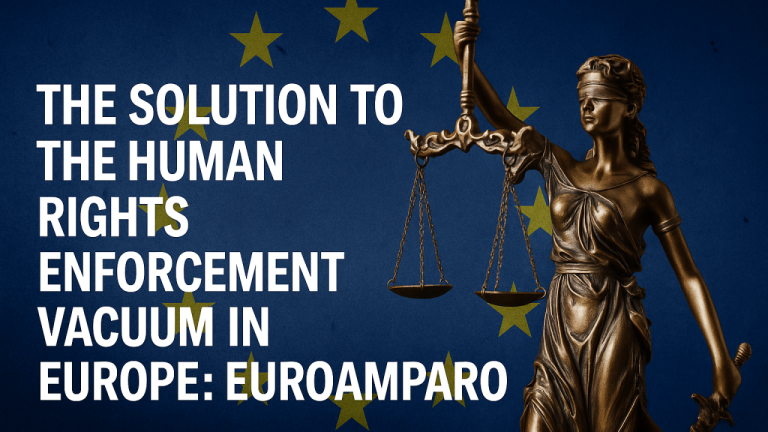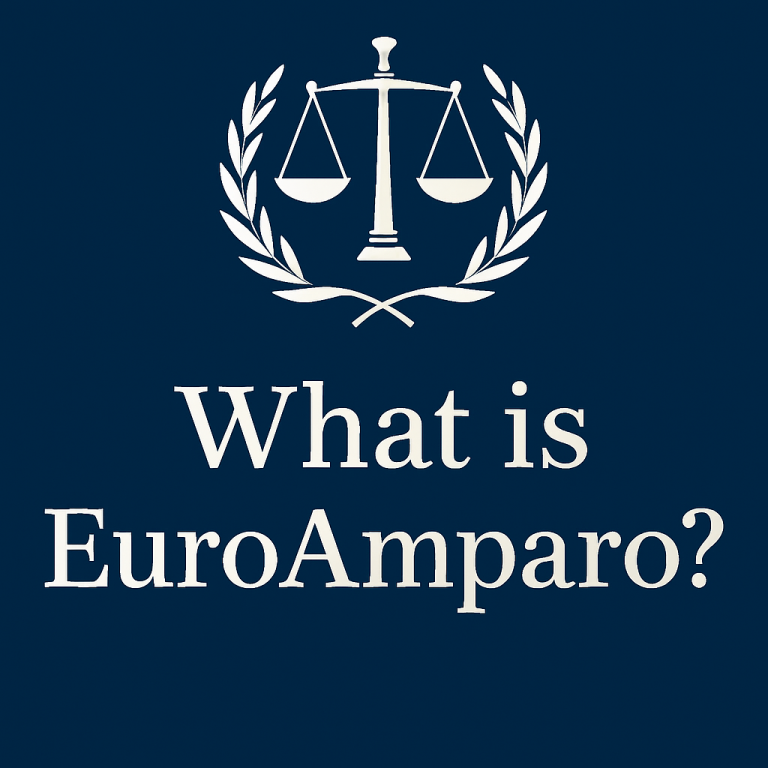 By Dr. Ernesto Briseño, MCIArb
By Dr. Ernesto Briseño, MCIArb
Abstract
This article offers a comparative constitutional critique of the European Union’s failure to enforce fundamental rights through meaningful administrative accountability, juxtaposed against the historically and normatively superior model of the Mexican Juicio de Amparo. Drawing on the author’s direct involvement in a cross-border marriage recognition case denied by Spanish and Bulgarian authorities—despite full legal validity—the article argues that the EU lacks not only procedural efficiency, but a culture of constitutional compliance. The Amparo, by contrast, functions as both a legal remedy and a civic philosophy: a lived recognition that rights without enforceability are hollow. Integrating references to Mexican jurists such as Fix-Zamudio, Briseño Sierra, Silva Herzog, and Cossío Díaz, alongside Kochenov, Spaventa, and Lenaerts on EU dysfunction, this paper contends that the EU has substituted institutional ritual for rights realization. The result is a Europe in which legal certainty dissolves into discretion, and fundamental rights are neither fundamental nor rights.
I. Introduction: Europe’s Broken Mirror
The European Union proclaims its commitment to fundamental rights through the Charter of Fundamental Rights, the Treaties, and the jurisprudence of the Court of Justice of the EU (CJEU). Yet, for those entangled in the machinery of Member State administrations, this promise often rings hollow. Beneath the constitutional language lies a bureaucratic culture that resists accountability, delays resolution, and conceals unlawful discretion behind layers of procedural ambiguity. The result is a legally fragmented Union, where the same family may be granted residence in Germany but expelled from Bulgaria, or registered as married in Italy and simultaneously rejected by Spain.
As a legal practitioner immersed in one such case—concerning a valid U.S. marriage between an EU citizen and a third-country national, recognized by at least nine EU countries that were consulted but rejected by Spain—I observed not mere administrative error, but institutionalized evasion. Not a single authority provided a reasoned decision grounded in law. Instead, they invoked vague formalities, contradictory references, and procedural silence. EU rights were denied not by law, but by administrative performance.
This reality invites comparison with a constitutional system designed precisely to prevent such evasion: Mexico’s Juicio de Amparo. This dissonance between promise and practice finds its most revealing counterpoint in a legal tradition where the Constitution lives in everyday procedure which is called: Mexico’s “Juicio de Amparo.”
II. The Juicio de Amparo: A Constitutional Culture of Accountability
The Juicio de Amparo, born from the liberal struggles of 19th-century Mexico, stands as one of the most advanced constitutional remedies in the world. Unlike abstract judicial review or politicized constitutional complaint systems, Amparo is an individual, direct, and enforceable mechanism through which any person may challenge the constitutionality of laws or acts of authority that violate their rights.
The term “Amparo” defies precise translation. While often rendered as “protection,” “relief,” or “safeguard,” none of these terms capture its full normative, cultural, and procedural weight. Amparo is not merely a legal remedy—it is a constitutional philosophy. It implies shelter, enforceability, dignity, and the active subjection of power to principle. For this reason, the word is preserved untranslated in comparative constitutional literature, much like habeas corpus or Rechtsstaat. To seek “Amparo” is not simply to ask for protection—it is to invoke the lived authority of the Constitution against the inertia or abuse of the state.
In the words of Fix-Zamudio (1993), the amparo represents “the constitutionalization of the ordinary.” It bridges the abstract norm with concrete lived experience, ensuring that every act of authority—whether by a minister or municipal clerk—is subject to legality. Humberto Briseño Sierra (1968) emphasized that the amparo embodies a civic expectation: that all public acts must be reasoned, justifiable, and open to scrutiny. Silva Herzog (1943) placed it among the revolutionary legal legacies of Mexico: a guardian of the citizen against the state.
Modern Mexican jurisprudence, led by jurists such as José Ramón Cossío Díaz, has deepened this tradition. The amparo is not merely a procedural tool; it is the expression of a legal culture in which constitutional supremacy is not theoretical. Decisions of the Supreme Court (jurisprudencia obligatoria) bind all authorities. Even at the lowest administrative levels, Mexican officials are trained and socially conditioned to provide written justification, anticipate review, and respect rights enforcement as integral to their legitimacy.
The Juicio de Amparo has also been recognized beyond Mexico’s borders. Devin C. McNulty (2022) describes amparo as “Mexico’s most sophisticated contribution to global constitutionalism,” noting its unique blend of individual protection and structural accountability. Similarly, Robert S. Barker (2011), in his comparative work on constitutionalism in the Americas, underscores amparo’s role as a democratic equalizer—an instrument that operationalizes rights beyond rhetoric. Bruce Zagaris, writing for the International Enforcement Law Reporter, has described the Amparo Process as a useful comparative example for countries seeking to strengthen judicial oversight of administrative actions.
This principle is not merely theoretical but is reinforced by jurisprudence. For instance, the Tesis Aislada XX.2o.P.C.8 C (11a.) underscores that the omission of a municipal authority to respond to a citizen’s request is considered an act of authority within the Juicio de Amparo. This affirms the obligation of authorities to provide justified responses, ensuring that administrative silence does not infringe upon individuals’ rights.[1]
III. Europe’s Missing Remedy: Rights Without Recourse
By contrast, the EU offers no equivalent to amparo. The Charter of Fundamental Rights lacks horizontal direct effect and remains judicially inert unless a specific provision of EU law is also implicated. Citizens cannot directly challenge national administrative acts before the CJEU. Instead, they are sent through exhausting national channels, SOLVIT mechanisms with no binding authority, or complaints to the European Commission that may take years—if ever—to reach adjudication.
As Keleman (2020) observes, this creates a regime where rights are aspirational but not enforceable. Administrative discretion is used not as a tool of governance, but as a veil of impunity. In a documented case involving a cross-border family, multiple authorities—including a Spanish consulate, civil registry, Ministry of Foreign Affairs and even Administrative Court—refused to register a valid apostilled marriage without ever stating that it was invalid. They simply circled responsibility, demanded redundant documentation, and offered no legal reasoning.
Such conduct would be unthinkable under amparo. The Mexican Constitution (Articles 103–107) obligates all public acts to be reviewable for legality and constitutionality. In contrast, EU Member States appear to enjoy de facto immunity from scrutiny, provided they act “administratively” rather than judicially.
IV. Bureaucratic Lawlessness as Governance
What emerges is not merely inefficiency, but structural lawlessness—a concept Kochenov (2015) has defined as “systematic tolerance for the arbitrary.” Lenaerts (2012) and Spaventa (2017) have argued that the EU legal order depends on mutual trust. But mutual trust is a dangerous illusion when one Member State acts in bad faith, and the EU institutions refuse to intervene.
In the case at hand, nine Member States confirmed the marriage’s validity. Spain remained silent. The European Parliament’s PETI Committee opened a formal petition (0439/2025); the European Commission received a legal complaint; the European Court of Human Rights acknowledged the case file (9246/25). Still, the administrative denial persisted—without reason, without remedy.
This is what I have called in earlier work the “hidden architecture of exclusion” (Briseño, 2025): a system designed not to reject rights outright, but to delay, confuse, and exhaust until the applicant disappears. The problem is not bad law—but no enforcement.
V. What If This Had Happened in Mexico?
Let us transpose the same facts to Mexico: a Mexican citizen returns home with their legally married foreign spouse, bearing an apostilled certificate. A migration official refuses residence, citing “formal doubts,” without issuing a resolution. The couple appeals, and again receives no legal reasoning—only silence.
In such a case, any judge would immediately grant amparo, obliging the state to act lawfully, provide reasons, and respect the right to family life under Articles 1 and 4 of the Constitution. Failure to comply could lead to contempt, removal from office, and binding jurisprudence. The idea that the state could simply “not respond” would be absurd, and also, that administrative silence (negative ficta) would trigger the right to demand justice before the Federal Courts.
The word “Amparo” cannot be translated without loss. It is at once remedy and ideology, shield and summons. It makes the Constitution audible to ordinary people. In Europe, no single word performs this function—nor does any institution. This difference is not accidental. It reflects two legal philosophies. In Mexico, the Constitution lives in administrative practice. In the EU, the Charter lives in brochures.
VI. Toward a European Amparo
The solution is not only legal—it is architectural. The EU must develop a supranational remedy that allows individuals to challenge violations of EU law by national authorities, without requiring national exhaustion in manifestly abusive or evasive cases. Models exist: amparo, the inter-American system’s Recurso de Protección, even national mechanisms like the Italian Ricorso Straordinario.
Such a system must be:
- Direct (not mediated by national courts);
- Individualized (triggered by rights-holders);
- Time-bound (subject to strict deadlines);
- Binding (with enforceable outcomes).
It should apply at least to violations of EU free movement, family life, non-discrimination, and the Charter. It must not be subject to political discretion. And it must be accessible, linguistically and procedurally, to ordinary people.
For all its declarations, Europe lacks a constitutional remedy that makes its promises real. In this void, a phrase that ought to define the European legal order remains suspended between aspiration and irony: la Justicia de la Unión Ampara y Protege (the Justice of the Union “Amparates[2]” and Protects). The words are beautiful—weighty, solemn, tender. Ampara (anglicized “Amparates”) does not merely mean “protects.” It evokes shelter, dignity, accountability; it carries the expectation of enforceability, the warmth of legality made real. It is a civic covenant, not just a procedural claim.
In Mexico, amparo is a word infused with moral force. It is not only a judicial mechanism but a cultural ethic—a recognition that rights must not only be declared, but shielded. To be “Amparado” is to be safeguarded against arbitrariness, to stand in the shadow of the Constitution with recourse and voice. This is the jurisprudential elegance that Europe has yet to internalize. It places the citizens under a hypothetical umbrella or anorak that shields them from the atrocities of unconstitutionality.
One need only hear the formula with which every Mexican citizen opens their constitutional petition: “Vengo a solicitar el Amparo y Protección de la Justicia Federal” (I come to request the “Amparo” and Protection of the Federal Justice). The phrase is not rhetorical—it is transformative. In it lies the essence of belonging to a republic governed by law. To speak those words is to know, with certainty, that one’s plea will be received, examined, and answered. It is a democratic affirmation that the law does not disappear at the edge of bureaucracy, and that dignity does not end where discretion begins. This beautiful request never goes unanswered, it will activate the judicial system immediately.
This invocation is both humble and powerful—an act of trust in the constitutional promise. It perfects the rule of law by operationalizing it. It converts abstract guarantees into real, lived justice. Until Europe can offer its citizens the same certainty—that the law is not merely available but accessible, not merely stated but enforced—it will continue to mistake procedural complexity for constitutional maturity. Without actual access to a procedure that guarantees promptly the application of those rights, they are nothing more than beautiful thoughts.
Today, EU citizens are promised fundamental rights, but denied the instruments to defend them. Until la Justicia de la Unión Europea truly Ampare y Proteja, the Charter will remain a brochure, and justice—an unkept promise. Beautiful to read and comforting to imagine, but de facto a theoretical lesson.
VII. Conclusion: Why Mexico Is More Constitutionally European Than Europe
The irony is profound: Mexico, often stereotyped as legally weak, has built a rights enforcement system more advanced, more immediate, and more culturally respected than anything the EU currently offers. In Mexico, even flawed and low-level officials fear amparo, and they fear it directly; in Europe, entire ministries ignore the Charter and can easily wear out citizens taking advantage of their feelings which get shattered in one process after the other until hope is lost.
As Silva Herzog once wrote, “The strength of a democracy is measured not by its declarations, but by the means it gives citizens to defend themselves.” Benito Juárez, el Benemérito de las Américas, taught us more simply—and more powerfully—what Europe has forgotten: “Entre los individuos como entre las naciones, el respeto al derecho ajeno es la paz” (amongst individuals and amongst nations, respect to the rights of others means peace). Mexico City hosts in its Alameda Central the Benito Juárez Hemicycle in which the former president himself is sitting with the Constitution in Hand flanked by female depictions of la Patria (the homeland) and the Law enlightening him with a torch. Until the EU offers its citizens a right they can defend, it will continue to mistake institutional complexity for justice and unlike Juárez’ Hemicycle which has a deep meaning, the EU Law is a meaningless brochure.
Mexico not only embeds constitutional meaning in its legal structures—it gives it monumental form. In the eastern borough of Iztapalapa, Mexico City, the Museo Cabeza de Juárez rises 13 meters into the air, a colossal sculpture of Benito Juárez atop a museum dedicated to his constitutional legacy. Created in 1976 to honor the centenary of his death, the monument gives material form to civic ideals: justice, republicanism, and constitutional supremacy. It is a stark contrast to the European Union’s abstraction of rights. Mexico gives its constitutional guardians a face 13 meters tall; the EU, a brochure.[3]
The Roman jurist Ulpian once defined justice as “Iustitia est constans et perpetua voluntas ius suum cuique tribuendi”—“Justice is the constant and perpetual will to give each their due.” In Mexico, through the Amparo, this principle is actionable: a judge, a clerk, even a municipal official is bound by it. In the European Union, this will is diffused, deferred, and too often denied. What should be constans et perpetua becomes conditional and elusive. Justice cannot live in declarations alone; it must be enforced with will, with tools, and with courage.
References
Briseño, E. (2025). The Hidden Architecture of Exclusion: A European Case of Administrative Evasion and the Deconstruction of Free Movement Rights. Self-published.
Briseño Sierra, H. (1968). El proceso administrativo en Iberoamérica. México: UNAM.
Burgoa Orihuela, I. (2002). El juicio de amparo. México: Editorial Porrúa.
Barker, R.S. (2011). Constitutionalism in the Americas: A Bicentennial Perspective. Duquesne University Law Review, 49(4), pp. 823–838.
Cossío Díaz, J. R. (2014). La justicia prometida: El Poder Judicial de la Federación de 1900 a 1910. México: Fondo de Cultura Económica.
De Witte, B. (2011). ‘The European Union as an International Legal Experiment’, in de Búrca, G. and Weiler, J.H.H. (eds.) The Worlds of European Constitutionalism. Cambridge: Cambridge University Press.
Fix-Zamudio, H. (1993). El juicio de amparo: Estudio doctrinal, jurisprudencial y legislativo. México: UNAM.
Góngora Pimentel, G. (2001). Introducción al estudio del juicio de amparo (8ª ed.). México: Porrúa.
Guild, E. (2004). The Legal Elements of European Identity: EU Citizenship and Migration Law. The Hague: Kluwer Law International.
Harlow, C. and Rawlings, R. (2007). Accountability and Law: Rights, Power and Democracy. Oxford: Oxford University Press.
Kochenov, D. (2015). The Missing EU Rule of Law. EUI Working Papers.
Kelemen, R. D. (2020). The European Union’s Authoritarian Equilibrium. Journal of European Public Policy, 27(3), 481–499.
Lenaerts, K. (2012). ‘Exploring the Limits of the EU Charter of Fundamental Rights’, European Constitutional Law Review, 8(3), pp. 375–403.
McNulty, D.C. (2022). ‘Amparo as a Reflection of Mexico’s Evolving Society and Judicial System’, International Journal of Legal Information, 50(2), pp. 97–113.
Silva Herzog, J. (1943). Historia de la Revolución Mexicana. México: Fondo de Cultura Económica.
Spaventa, E. (2017). Earned Citizenship: Understanding Union Citizenship through Its Scope. In D. Kochenov (Ed.), EU Citizenship and Federalism: The Role of Rights (pp. 204–225). Cambridge: Cambridge University Press.
Tena Ramírez, F. (1976). Derecho constitucional mexicano. México: Editorial Porrúa.
Tribunal Colegiado de Circuito. (n.d.). Acto de autoridad para efectos del juicio de amparo. Lo constituye la omisión de un ayuntamiento municipal del Estado de México de dar respuesta a una solicitud formulada por un particular. Tesis Aislada XX.2o.P.C.8 C (11a.). Semanario Judicial de la Federación.
Tushnet, M. (2003). “Comparative Constitutionalism: An Introduction”. Michigan Law Review, 101(6), 1899–1924.
Ulpian. Digest 1.1.10. Translated by A. Watson (1985). The Digest of Justinian. University of Pennsylvania Press.
Zagaris, B. (1991). “The Amparo Process in Mexico and its Lessons for Other Legal Systems”. International Enforcement Law Reporter, 7(12), 439–.
[1] This principle is not merely theoretical but is reinforced by jurisprudence. For instance, the Tesis Aislada XX.2o.P.C.8 C (11a.) underscores that the omission of a municipal authority to respond to a citizen’s request is considered an act of authority within the Juicio de Amparo. This affirms the obligation of authorities to provide justified responses, ensuring that administrative silence does not infringe upon individuals’ rights.
[2] “Amparates” is a rhetorical neologism, derived from the Spanish verb amparar and used here intentionally in English to reflect the irreplaceable depth of the Mexican legal term Amparo. No equivalent term in English conveys the full constitutional, procedural, and philosophical meaning of Amparo—which encompasses not just “protection” but enforceable legality, civic dignity, and juridical shelter. The term is preserved untranslated in much comparative legal scholarship for this reason.
[3] Museo Cabeza de Juárez. Sculptor: Luis Arenal Bastar. Architects: Lorenzo Carrasco Ortiz and Miguel Ramírez Bautista. Inaugurated March 21, 1976. Located in Iztapalapa, CDMX.
#FundamentalRights #Amparo #EULaw #ComparativeLaw #RuleOfLaw




